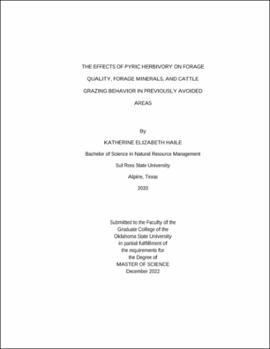| dc.contributor.advisor | Goodman, Laura E. | |
| dc.contributor.advisor | Efuhlendorf, Samuel D. | |
| dc.contributor.author | Haile, Katherine Elizabeth | |
| dc.date.accessioned | 2023-08-02T19:47:06Z | |
| dc.date.available | 2023-08-02T19:47:06Z | |
| dc.date.issued | 2022-12 | |
| dc.identifier.uri | https://hdl.handle.net/11244/338779 | |
| dc.description.abstract | Pyric herbivory is grazing behavior driven by animal selection of palatable regrowth following fire. Land managers can apply pyric herbivory by patch burning portions of a pasture and allowing cattle access to unburned and freshly burned areas simultaneously. Other studies have shown that cattle select for burn patches and that freshly burned areas have higher nutritional quality. In this study, located in the mixed grass prairie of Oklahoma, we strategically burned areas cattle avoided to modify their behavior and redistribute grazing pressure in a pasture. We also evaluated the effects of patch burn grazing on vegetation composition, forage quality, and mineral content. Five cows, individually equipped with a GPS collar, grazed one of three study pastures during the summer of 2020 and 2021. At the end of year one, cattle distribution was analyzed using a Hot Spot analysis to determine avoided areas. Burn patches were selected from avoided areas. In our second year, two patches were burned in the spring and summer within each pasture with cows released in the pastures following the dormant season burn. The vegetation composition, nutritional components, and mineral contents were sampled every two months following fire until the end of the growing season. Cows were successfully drawn to previously avoided areas using patch burning. We found 83% of the dormant season burn patches experienced an increase in cattle use. While 60% of the growing season burns showed higher cattle use with fire. Nearly all forage nutritional components measured were higher in the burned patches compared to unburned areas during the same sampling session until approximately six months after fire. Grass and forb cover and total biomass was also statistically the same as unburned areas six months post-fire. Pyric herbivory successfully altered grazing distribution, by increasing cattle use of avoided areas and increasing mineral content and quality of forage. | |
| dc.format | application/pdf | |
| dc.language | en_US | |
| dc.rights | Copyright is held by the author who has granted the Oklahoma State University Library the non-exclusive right to share this material in its institutional repository. Contact Digital Library Services at lib-dls@okstate.edu or 405-744-9161 for the permission policy on the use, reproduction or distribution of this material. | |
| dc.title | Effects of pyric herbivory on forage quality, forage minerals, and cattle grazing behavior in previously avoided areas | |
| dc.contributor.committeeMember | Weir, John R. | |
| dc.contributor.committeeMember | Murray, Bryan D. | |
| osu.filename | Haile_okstate_0664M_17964.pdf | |
| osu.accesstype | Open Access | |
| dc.type.genre | Thesis | |
| dc.type.material | Text | |
| dc.subject.keywords | forage nutrition | |
| dc.subject.keywords | grazing managment | |
| dc.subject.keywords | patch burn grazing | |
| dc.subject.keywords | pyric herbivory | |
| dc.subject.keywords | range forage | |
| dc.subject.keywords | range nutrition | |
| thesis.degree.discipline | Natural Resources Ecology and Management | |
| thesis.degree.grantor | Oklahoma State University | |
